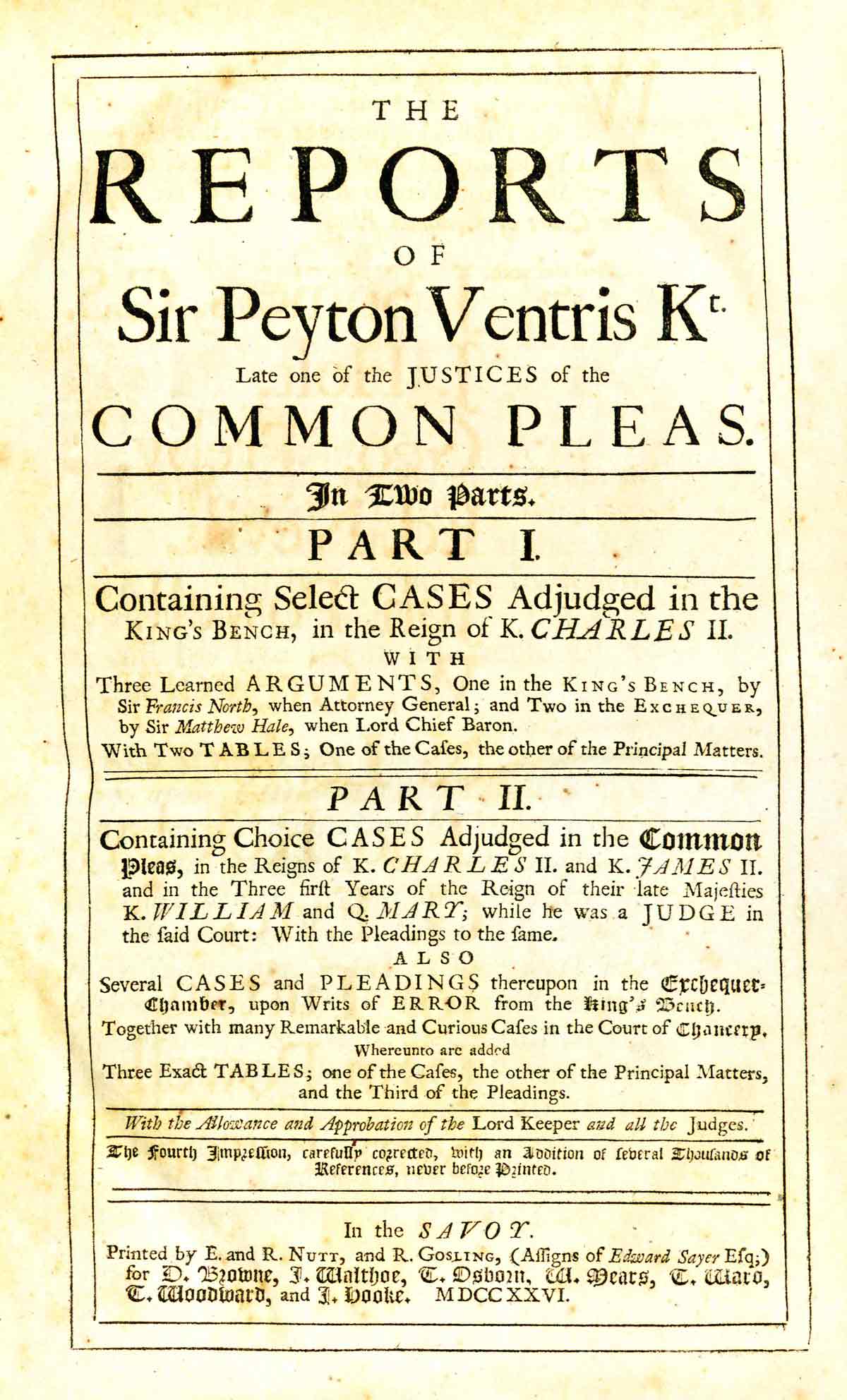Difference between revisions of "Reports of Sir Peyton Ventris"
| Line 1: | Line 1: | ||
{{DISPLAYTITLE: ''The Reports of Sir Peyton Ventris''}} | {{DISPLAYTITLE: ''The Reports of Sir Peyton Ventris''}} | ||
| − | + | ||
===by Sir Peyton Ventris=== | ===by Sir Peyton Ventris=== | ||
__NOTOC__ | __NOTOC__ | ||
| Line 18: | Line 18: | ||
}}Sir Peyton Ventris (1645-1691) entered the Middle Temple in 1664 and was called to the bar in 1671.<ref>Paul D. Halliday, [http://www.oxforddnb.com/view/article/28197 "Ventris, Sir Peyton (1645–1691)", ''Oxford Dictionary of National Biography'', Oxford University Press, 2004; online edn, Jan 2008, accessed 5 June 2013. (Subscription required for access.)</ref> He rose to prominence after the Revolution of 1688, becoming serjeant-at-law, justice of the Court of Common Pleas, and rising to a knighthood in 1689.<ref>Ibid.</ref> Ventris' compilation of reports, covering cases from 1668-1691, has "generally been considered to be of good authority"<ref>W. S. Holdsworth, ''A History of English Law'' (London: Methuen & Co., Sweet and Maxwell, 1924), 6:561.</ref> with "but few of the cases censured."<ref>John William Wallace, ''The Reporters, Arranged and Characterized with Incidental Remarks'', 4th ed., rev. and enl. (Boston: Soule and Bugbee, 1882), 345.</ref> They "endure as among the most important written during the Restoration."<ref>Halliday, "Ventris, Sir Peyton."</ref> | }}Sir Peyton Ventris (1645-1691) entered the Middle Temple in 1664 and was called to the bar in 1671.<ref>Paul D. Halliday, [http://www.oxforddnb.com/view/article/28197 "Ventris, Sir Peyton (1645–1691)", ''Oxford Dictionary of National Biography'', Oxford University Press, 2004; online edn, Jan 2008, accessed 5 June 2013. (Subscription required for access.)</ref> He rose to prominence after the Revolution of 1688, becoming serjeant-at-law, justice of the Court of Common Pleas, and rising to a knighthood in 1689.<ref>Ibid.</ref> Ventris' compilation of reports, covering cases from 1668-1691, has "generally been considered to be of good authority"<ref>W. S. Holdsworth, ''A History of English Law'' (London: Methuen & Co., Sweet and Maxwell, 1924), 6:561.</ref> with "but few of the cases censured."<ref>John William Wallace, ''The Reporters, Arranged and Characterized with Incidental Remarks'', 4th ed., rev. and enl. (Boston: Soule and Bugbee, 1882), 345.</ref> They "endure as among the most important written during the Restoration."<ref>Halliday, "Ventris, Sir Peyton."</ref> | ||
| − | + | ==Evidence for Inclusion in Wythe's Library== | |
| − | |||
| − | |||
| − | |||
| − | |||
| − | |||
| − | |||
| − | |||
| − | |||
| − | ==Evidence for Inclusion in Wythe's Library== | ||
| − | |||
==Description of the Wolf Law Library's copy== | ==Description of the Wolf Law Library's copy== | ||
Revision as of 15:28, 28 January 2014
by Sir Peyton Ventris
| The Reports of Sir Peyton Ventris | |
|
Title page from The Reports of Sir Peyton Ventris, volume one, George Wythe Collection, Wolf Law Library, College of William & Mary. | |
| Author | Sir Peyton Ventris |
| Published | [London] In the Savoy: Printed by E. and R. Nutt and R. Gosling for D. Browne |
| Date | 1726 |
| Edition | Fourth impression, carefully corrected |
| Language | English |
| Volumes | 2 volumes in 1 volume set |
| Desc. | 32 cm. |
Sir Peyton Ventris (1645-1691) entered the Middle Temple in 1664 and was called to the bar in 1671.[1] He rose to prominence after the Revolution of 1688, becoming serjeant-at-law, justice of the Court of Common Pleas, and rising to a knighthood in 1689.[2] Ventris' compilation of reports, covering cases from 1668-1691, has "generally been considered to be of good authority"[3] with "but few of the cases censured."[4] They "endure as among the most important written during the Restoration."[5]
Evidence for Inclusion in Wythe's Library
Description of the Wolf Law Library's copy
Bound in contemporary calf and rebacked in period style with raised bands and lettering piece to the spine and renewed endpapers. Purchased from The Lawbook Exchange, Ltd.
View this book in William & Mary's online catalog.
References
- ↑ Paul D. Halliday, [http://www.oxforddnb.com/view/article/28197 "Ventris, Sir Peyton (1645–1691)", Oxford Dictionary of National Biography, Oxford University Press, 2004; online edn, Jan 2008, accessed 5 June 2013. (Subscription required for access.)
- ↑ Ibid.
- ↑ W. S. Holdsworth, A History of English Law (London: Methuen & Co., Sweet and Maxwell, 1924), 6:561.
- ↑ John William Wallace, The Reporters, Arranged and Characterized with Incidental Remarks, 4th ed., rev. and enl. (Boston: Soule and Bugbee, 1882), 345.
- ↑ Halliday, "Ventris, Sir Peyton."
